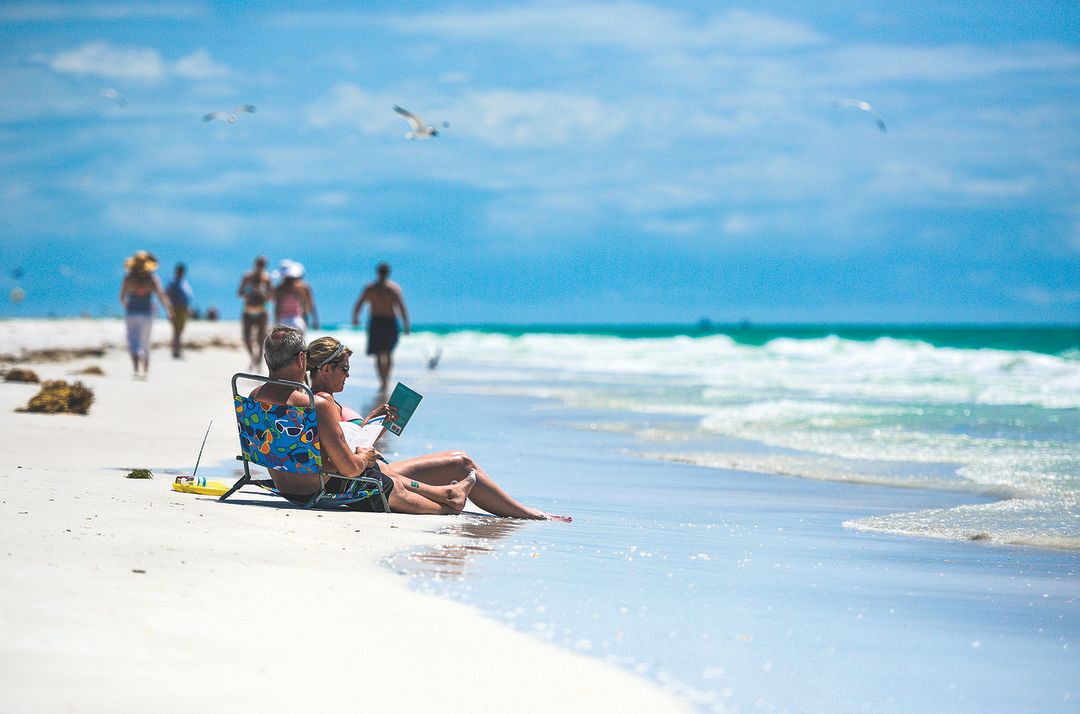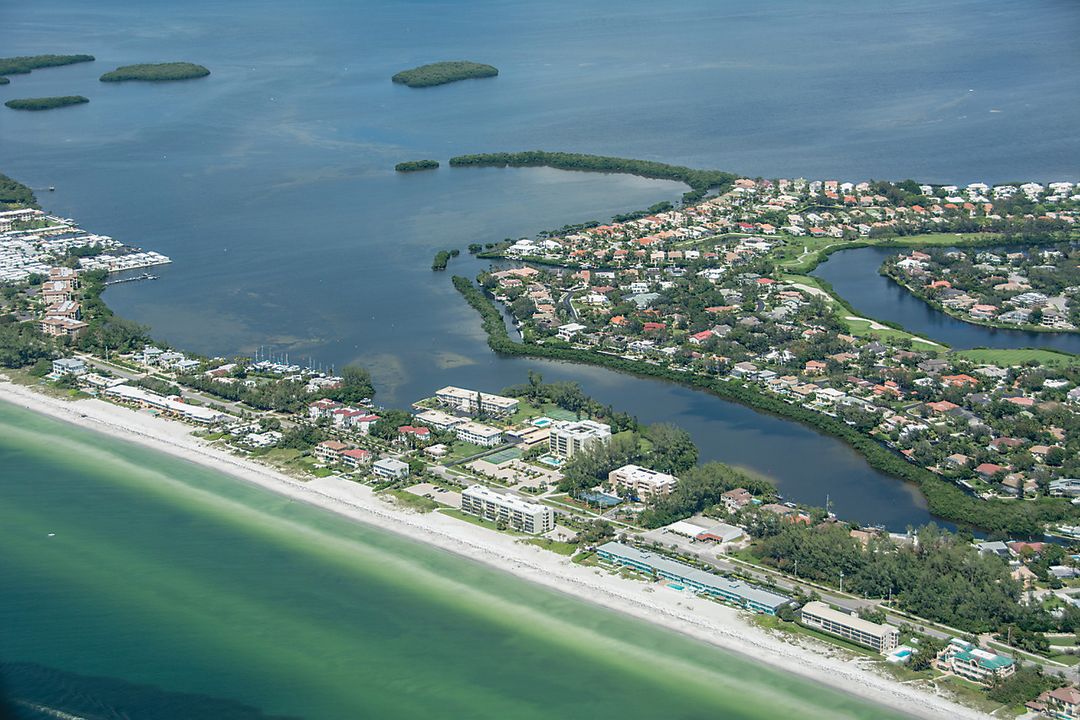
Recycling Vast Expanses of Sand Has Become the Price of Paradise
For 20 years, New Pass Grill & Bait Shop owner Jim Wallace has watched history repeat itself. Boaters motor through New Pass, one of five inlets connecting Sarasota Bay to the Gulf of Mexico, day after day, week after week. Dredges arrive every few years, pump about a billion pounds of sand from the inlet onto neighboring beaches, usually at a cost of several million dollars, and leave, just to come back some three to five years later and do the same thing.
When the pass is too clogged with sand to be navigable, as it has been since last summer, the Coast Guard erects warning signs, and boaters travel at their own risk. While small boats may be able to make it through—if their captain knows the pass well—boats of 45 feet or more probably can’t. The pilot of a 59-footer recently attempting to thread his way through New Pass hit a sand shoal and ripped off three expensive drive units. During another treacherous period some years ago, a 35-foot, steel-hulled ketch sank and remained dead-center in New Pass for months.
“We don’t take any big boats out of New Pass anymore,” Capt. Kenneth Waibel, who shuttles big vessels from Sarasota to the north and south for customers, said in February. “It’s a navigational hazard. It’s just too dangerous.”

Image: Everett Dennison
Bait Shop owner Wallace has seen how rapidly the channel moves—or all but disappears—as sand flows from nearby beaches and, trapped by the loopy currents, builds and shifts from day to day. “When you start screwing around with Mother Nature you better have deep pockets,” he says. “It is very expensive, time-consuming and labor-intensive.”
And yet, in a few months, the City of Sarasota will send dredges out to the pass to start the cycle again. City engineer Alex DavisShaw estimates the project will cost $3 million; the primary aim, she points out, is not to keep the channel open, although that will be a beneficial side effect. The real purpose: to use the dredged sand to replenish Lido and Longboat’s eroded beaches.
Ironically, the region’s beaches and inlets, those magnificent natural resources that draw so many people here, are no longer in their natural state. Cliff Truitt, a coastal engineer who has studied and managed the shorelines of Sarasota and Manatee counties during the last three decades, says, “It hasn’t been a natural system for many years. It is being manipulated and will be for the rest of time.”
Over the last century, the region’s coastal environment has been altered and augmented, almost always to promote and protect development. In their natural state, inlets change and move, sometimes shrinking, and sometimes expanding the shoreline. But today such natural behavior would threaten not only Southwest Florida beaches but billions of dollars of prized real estate, and communities consider it essential to control inlets’ flow.
That’s true for seaside communities all over the country. Nationwide, the U.S. Army Corps of Engineers spends nearly $1 billion every year on inlet-related efforts that, beyond navigation, recognize that large-scale management of passes preserves beaches, protects coastal environments, increases recreational opportunities and confers massive economic benefits on local communities.
“This is one of the few projects I work on that gives back more than we spend,” says city engineer DavisShaw. “The money [beaches] generate because of these improvements is far more than the cost.”
Passes are complex geological features, and attempts to control them can have unintended consequences. Venice Inlet, at the southern end of the bay, is loaded with tons of limestone rocks jutting out into the Gulf for hundreds of feet along both sides of the pass. That’s provided a reliable, deepwater inlet into the Gulf. But it’s also robbed sand from downdrift beaches including Venice Beach, which has required renourishing for decades.
In 1983, Midnight Pass, which had run between Casey and Siesta keys throughout recorded history, began to migrate north, threatening two beachfront homes. Sarasota County commissioners allowed the homeowners to use a bulldozer and a few men to push sand into the shallow inlet, which ended up closing it. Boaters and marine life lost access to the Gulf, and for years citizens argued about reopening Midnight Pass. Several attempts by the county to get state and federal permits to reopen the pass failed, and it remains closed today.
That’s not the only time efforts to manipulate the region’s passes have sparked community battles. For the last few years, a plan to renourish South Lido with sand from Big Pass has been stalled by fierce opposition.

Buttonwood Harbor on Longboat Key is on a list of places where a storm could create a new inlet.
Image: Jack Elka
New Pass is said to have been created by a hurricane in 1848. In the 1920s, in what proved to be the precursor to many attempts to alter the region’s inlets, New Pass was dredged in a grand plan to create a deepwater port in Sarasota. The deep channel continued from the pass across Sarasota Bay to Payne Terminal, which is now home to Centennial Park and its popular public boat ramps. The plan flopped because New Pass, and the channel through the bay, filled up with sand in short order. The 58-acre spoil island created during the channel dredging remains today as City Island, one of many artificially created lands that rise out of Sarasota Bay. Circus baron-turned-developer John Ringling constructed Bird and Lido keys out of a clump of mangrove islands in the mouth of Big Pass, which destroyed some of the most fertile sea grass meadows of the time.
While human beings have succeeded at reshaping much of the coastal environment, they can’t prevent nature from closing existing inlets or opening new ones—sometimes overnight. Five inlets closed in the region during the last 150 years; and back in 2002, a pair of University of Florida coastal scientists identified more than a dozen spots along the barrier islands where conditions are ripe for the creation of new inlets. Most are narrow stretches with low elevation and orientation to the typical direction of big waves from big storms. One of the most likely spots is Buttonwood Harbor, which is in the middle of Longboat Key and may have once separated the northern and southern portion of the key; it closed sometime in the 1880s.
Humans can’t stop tides and storms, but they have become adept at what DavisShaw calls “recycling” sand from the passes to the beaches and back again. Every few years, New Pass fills up with sand, most of it eroded from nearby beaches. Beginning in 1964, the federal government provided funds for the Army Corps of Engineers to dredge sand out of New Pass to place on nearby beaches, but in the spring of 2003, the $4 million funding cap set by Congress had been met, and the City of Sarasota and Longboat Key took over the dredging. They’ve used funds from a variety of sources, including self-imposed levies by Longboat Key residents and state Tourist Development money.
Longboat and Sarasota take turns dredging the channel and pumping the sand back where it came from. “It’s top-quality, easily accessible, renewable sand,” DavisShaw explains. It’s also “cost-effective,” she says, to use nearby sand rather than get it from other places. Longboat dredged the pass late in 2016, but, in part because of Tropical Storm Hermione, it filled up more quickly than usual. Now it’s the city’s turn, and DavisShaw expects to secure the necessary approvals and begin dredging soon.
“It’s a win-win,” she says. “We’re keeping the channel in the authorized alignment and using that sand to maintain the beach.”
DavisShaw and other local officials have accepted the need to manage natural systems that affect the region’s economy, tourism, boating industry and homeownership. Still, maintaining the passes and beaches raises difficult questions: How often should we replenish what Mother Nature takes away? What will be the effect if we do nothing? Who is going to pay the millions of dollars for the dredging and beach nourishment efforts every few years when all the sand added to the system clogs our inlets? And few people are asking the biggest question of all: How long do we have before sea levels rise and engulf the region’s beaches, dooming all our puny human efforts?
Tom Bayles won a first-place Charlie Award from the Florida Magazine Association for “Sand Storm” in our July 2016 issue; and a Silver Award from the FMA for “Deadly Waters” in our February 2017 issue.